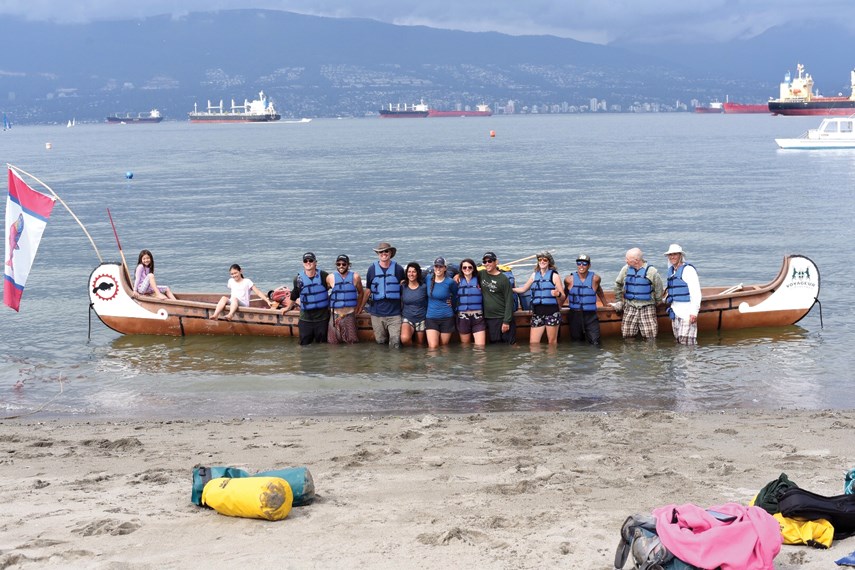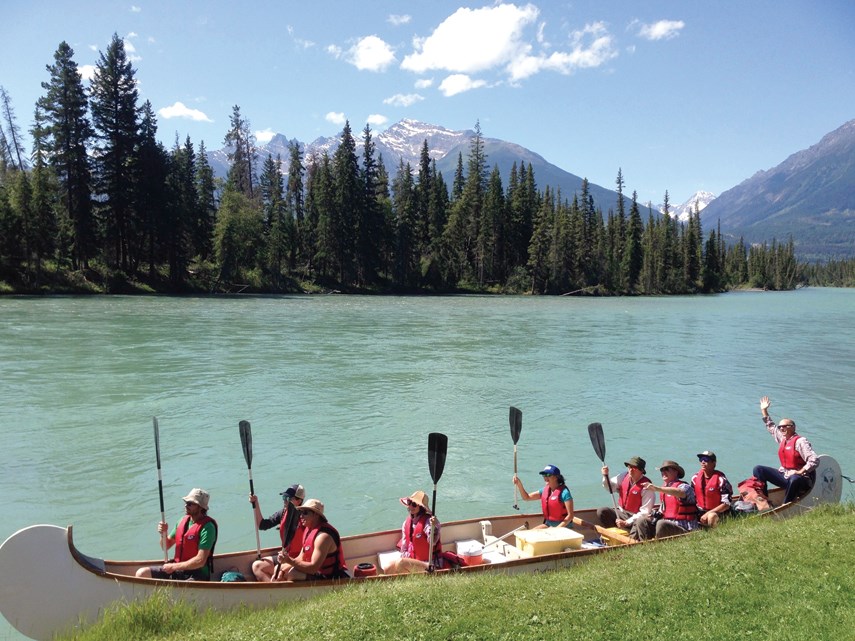For a month they paddled – and paddled and paddled and paddled.
The group travelled 1,400 kilometres up and down and along the mighty Fraser River, carving the same path that salmon one day seek when setting forth to fulfil their life’s purpose, en route from headwaters to open ocean.
The group travelled by canoe, by raft, and occasionally on foot. At night, they camped and rested their weary bodies under the stars. Early the next morning, it would all start again. If the sublime, crashing flow of water ever threatened to steer the group off course, they still endeavoured to keep their eyes on the prize – even if they were sopping wet.
“Those of us growing up in Vancouver, we experienced the Fraser River as almost an obstacle more than anything else. To actually understand the whole river, to go to essentially its source in the Rockies …” Jeffrey Gibbs trails off, lost in contemplation of the grand journey he’s recently undertaken and in awe of one of the world’s – if not the world’s – greatest salmon rivers.
For a month spanning mid-July to mid-August, Gibbs was one of a dozen participants in Rivershed Society of BC’s sustainable living leadership program. Beginning in the Mount Robson region where Alberta meets B.C., participants set forth on a journey along the Fraser River which would take them through 10 of B.C.’s 14 biogeoclimatic zones and a multitude of communities, all of which are in some manner connected to the vast watershed, or so the group learned.
The purpose of Rivershed Society’s program was simple: to teach participants about watershed conservation, protection and restoration, and educate them on how to be effective campaigners when it comes to reducing our ecological footprint.
“We need to have a lot of people involved,” advises Gibbs, a North Vancouver resident and professional photographer, writer and videographer, a few days after returning to shore. “If all the participants in these programs do projects that involve a number of people in each project, then you end up getting a ripple effect of a lot more people engaged.”

Every day started the same, according to Gibbs, but ended with the group always having learned something new and essential. As they paddled from area to area, such as from Tete Jaune to Crescent Spur or getting a layover day in Goat River valley or the Xatsull First Nation, they were always joined by a host of facilitators, educators and community leaders who imparted their knowledge on watersheds, the environment and their serene backyards.
“We’re learning things about how there’s a lot of need to restore damaged areas of the watershed. We might visit with a specialist who knows about salmon streams and how to rehabilitate them. We’d stop somewhere and meet a specialist, or they would join us for a day and we would learn and then we would carry on the journey,” says Gibbs.
Whenever Gibbs mentions the Fraser River or the watershed, he can’t help but insert salmon into the conversation. Salmon is “just a part of our lifestyle here” growing up in B.C., says Gibbs – the journey of chinook and coho was hard to ignore over the course of the sustainable living leadership program.
In late June, a landslide near Big Bar, a remote, rugged canyon in the Interior north of Lillooet, was reported. Huge pieces of rock from a 125-metre cliff crashed into the Fraser River, creating a large waterfall. The resulting obstruction caused salmon migrating upstream to be unable to naturally proceed beyond the landslide – and powerless to reach their spawning grounds.
A concerted effort involving federal and provincial levels of government, as well as First Nations, was implemented, with organizers going as far as airlifting migrating salmon past the obstruction using helicopters. At press time, migrating chinook and sockeye salmon have started to be able to swim through the landslide unaided following a decrease in water levels and crews successfully managing to shift some of the huge boulders, according to Canadian Press.
“Salmon are in a crisis and so if we’re going to save salmon we have to do a lot of things. A lot of their spawning channels have been destroyed. We need to rebuild and we need to restore landscapes which have been destroyed by fires, by mines, by other impacts, and that’s going to be expensive and it’s going to take a lot of communities to do that,” says Gibbs.
While the Big Bar landslide could have potentially prevented millions of migrating Fraser River salmon from reaching their spawning grounds, there’s still the risk that a returning run of 1.5-million pink salmon won’t be able to get past the landslide, Canadian Press reports.

Gibbs experienced his Fraser River journey through two lenses: on one hand he was – and is – concerned about the degradation of the watershed and the environment more broadly, and on the other hand he was simply in awe of the river and its surrounding environment’s beauty despite everything.
Describing a vast stretch of waterway linking the river from Williams Lake south to Lillooet that took days to complete, Gibbs talks about the lack of towns and abundance of “world-class scenery” along the way. He describes huge canyons and sage bush and “tabletop-looking mountains” which pepper the old village sites of the First Nations that were there. As they paddled, they saw big horn sheep, grizzly bears and “all this presence of Indigenous history.”
He wants to encourage people to treasure the river and its abundance of life and importance for a multitude of communities in B.C. Gibbs notes that among his favourite workshops the group endured while paddling from Point A to Point B was one on how to be an effective campaigner for creating projects to support watersheds such as the Fraser River. He’s in the process of developing a photography contest that’ll encourage residents along the Fraser watershed – from the Pacific Ocean to the Rockies – to submit pictures of their communities.
“There’s a need to involve people in understanding the threats and the solutions to healing and protecting the Fraser watershed. The idea is the photo contest will engage people to take photos where they live throughout the watershed,” he says.
Maybe his photo contest will generate some empathy for the watershed and the B.C. environment as a whole, he says. “I’m looking at it in terms of the global issues that are going on all over the world. We need to look at how do we restore the places that we’ve damaged.”



